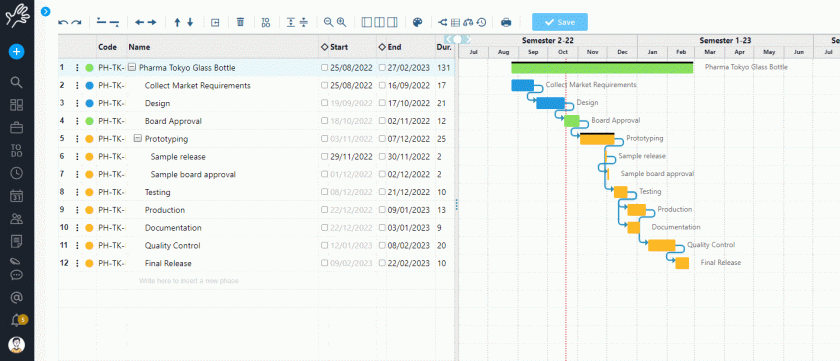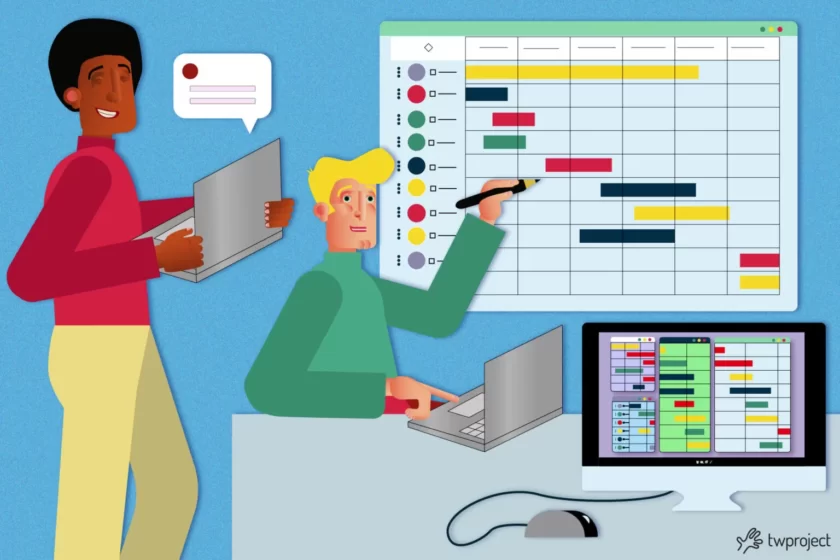A Work Breakdown Structure, abbreviated with WBS, is a visual tool for the definition and tracking of a project deliverable and all the small components necessary to create it.
With a Work Breakdown Structure, the project manager can concentrate on what he has to accomplish as he approaches the project deadline.
This is a fundamental tool for a PM as it helps to plan, manage and evaluate any type of project.
CONTENT INDEX
With a WBS, we start from the result or the desired final product, we analyze it and decompose it into smaller deliverables or the activities necessary to create it.
In a WBS, the deliverable can be an object, a service, or an activity.
Focusing on deliverables, rather than methods – the “what”, not the “how” – a Work Breakdown Structure helps to eliminate unnecessary and superfluous work.
A weighted WBS helps in planning, costs estimation and risk analysis.
It is usually a graph or a visual diagram that defines the temporal sequence and the process of a project. It breaks down into each activity that will be performed during the project life cycle.
A WBS is often represented as a structure, as a summary, but can also be organized using tabulations or other visual organizational systems.
What are the purposes of a Work Breakdown Structure?
Here are some of the benefits that arise whit the creation of a Work Breakdown Structure:
- Provides a visual representation of all parts of a project
- It offers a continuous vision on how the whole project proceeds, helping its management
- Defines specific and measurable results
- Decomposes the job into manageable blocks
- Provides a system that allows successful experiences to be repeatable
- Sets a basis for estimating costs and allocating resources, both human and other
- Avoids overlaps or lack of work for the resources
- Minimizes the possibility of forgetting a critical result or a risk.
A well-done WBS can make the team work like a well-oiled machine, with the following advantages:
- Increases productivity
- Helps project managers predict results based on various scenarios
- Helps with the project organization
- Helps to describe the scope of the project to stakeholders
- Helps to distribute responsibilities
- Allows a correct estimate of costs, risks and time
- Increases and improves communication
- Allows more creativity and brainstorming
- Focuses on the final results
- Organizes the details
- Prevents potential problems
- Addresses programming issues
- Helps to manage risks
- Gives flexibility to the team
- Eliminates confusion
- Provides clear descriptions of the tasks of each team member
- Provides a basis for a clear report on the status of the project, since each task is a measurable unit
Work Breakdown Structure templates
For a WBS, different types of formats and templates are possible:
- Graphic format: emphasizes visual visualization of the project;
- Linear structure: presents a time interval and dependencies between the components of a project;

- Hierarchical structure: puts at the top the most important elements of a project for a greater emphasis;
- Tabular view: allows team members to easily navigate to the most relevant sections for them.
Not all projects require the same type of format.
This can and must be adapted to the type of project and the type of members in the team.
Types of Work Breakdown Structure
A Work Breakdown Structure can be organised according to different logics, based on the nature of the project, the methodological approach chosen and the needs of the team. Understanding these types is essential for correctly structuring the project scope, defining an effective project plan and building a solid foundation for management.
- Deliverable-based WBS: This is the most common and widely used form. In a deliverable-based WBS, the project is broken down into tangible results to be achieved. Each deliverable represents an intermediate or final objective, which in turn is broken down into activities or work packages. It is an ideal approach for projects where the final products or outputs are clearly defined from the outset, such as software development, building construction or marketing campaign delivery.
- WBS by project phases: The WBS by project phases organises the work according to the main phases of the project: initiation, planning, execution, monitoring and closure. Each phase is treated as a main element of the structure, from which specific activities and work packages branch out. This model is useful in complex projects, especially when it is essential to ensure an orderly sequence and precise control of progress between phases.
- Phase-based WBS: Similar to the previous type but with a higher degree of formalisation, phase-based WBS is often used in regulated or long-term contexts, such as engineering, aerospace, public projects or those funded by external bodies. In these cases, the phases are usually strictly documented, with precise constraints on quality, costs and timing. Each deliverable is linked to a phase and must be completed before moving on to the next one. This is ideal when the scope of work is strictly defined and formally monitored.
- Hierarchical structure: The hierarchical structure is the classic representation of the WBS, constructed as a tree diagram with the project at the top and subsequent levels descending in depth. Each hierarchical level further breaks down the work of the higher level, making the entire hierarchical breakdown of the project visible. This type of visualisation helps the team immediately understand the priorities and relationships between the different elements of the project.
- Tabular view: the tabular view is a representation of the WBS in table format: each row can represent a work package, with columns dedicated to description, manager, duration, progress status and notes.
This mode is very practical in modern project management tools, where it is possible to create a breakdown of the work in a simple and interactive way, directly linking project team members to tasks, visualising the work in Gantt charts and monitoring project deliverables.
Tools such as Twproject allow you to create a WBS from scratch or using predefined templates, speeding up the entire process.
Work Breakdown Structure: Best practices
1. Focus on the final results, not on the methods / actions.
The key lies in thinking about the “what”, not about “how”.
The main purpose of a WBS is to define the main deliverable taking into consideration the small components that compose it.
If the deliverable is not a physical product, a specific and measurable result must be provided in any case.
For example, if you are creating a WBS for a professional service, you need to define the results of that specific service.
2. 100 percent rule
The work represented by the Work Breakdown Structure must include 100% of the work required to complete the general result without including any extraneous or unrelated work.
Even sub-activities, at any level, should be taken into account, because are all necessary to complete the main activity.
In other words, the elements in the second level are equal to 100% and the elements in the third and lower levels are positioned within the percentage of the higher level with respect to them.
The finished project should never give a sum greater or less than 100 percent.

3. 8/80 rule
One of the common mistakes is to break down the work too much or not decompose it enough. There are several ways to decide when a work package is small enough without being too small.
The 8/80 rule is one of the most common suggestions: a work package should not take less than eight hours of work, and no more than 80 hours.
Other rules suggest not to give activities that exceed ten working days – which is equal to 80 hours if you consider a full-time employee.
In other words, a work package should not take more than a month to complete.
Clearly, this rule should be applied if it makes sense within the project and the industry.
4. Attention to the level of detail
In general, work packages should provide activities that can be completed by a team member, or by the team in general, within a reference period.
If the team is less experienced and needs more supervision and coaching, one solution is to make the work packages smaller and shorter.
If you have a deliverable that may take longer to complete or cost more than your given budget, it may be useful to divide the project into smaller deliverables with shorter work times.
With a more frequent reporting and review time, you can solve problems and solve them earlier.
Another suggestion is to create tasks and delegate activities at the beginning of a project, but in case and if necessary create new tasks and new delegations during a project.
We gained a time optimization thanks to the structuring of projects with tools such as the template generator and cloning function of entire projects or portions

How to create a Work Breakdown Structure
The first step to create a WBS is to bring the team together.
Regardless of whether the team works in an office or remotely, it is essential that members participate in identifying derivables.
Collaborators must know exactly what is happening.
The project manager must also assemble the key documents of the project in order to start the development of the Work Breakdown Structure: the project charter, the problem that the project will solve, the scope definition, the documentation that refers to the existing processes for the project management, etc.
To start the creation, it is necessary to define the level one, ie the main result of the project.
Then gradually add as many details as possible. From the second level you will descend to the smaller pieces up to the third level, to the fourth level, and more, if necessary.
It is important to always define what is required in the previous level in the most detailed way possible before moving on to the next levels. It will be essential to further break down the work.
Here is a brief structure that can be useful for writing a WBS:
- Determine and describe the project result;
- Highlight all the necessary phases of the project;
- Divide the final results into manageable tasks;
- Assign each section and make sure that each owner, ie the corresponding team member, has all the information, skills and knowledge necessary to complete the job.
- Ensure frequent feedback. The WBS is a dynamic document, whose content can be revisited, even frequently, to ensure the correct execution and delivery of the project.
In conclusion, the creation of a Work Breakdown Structure is a team effort and is the point of arrival of multiple inputs and perspectives for the given project.
Its goal is to make a large project more manageable.
The deconstruction into smaller blocks means that work can be done simultaneously by different team members. This will lead to better productivity and easier management of the project in general.
Have you ever created a WBS structure for your project? What tools and methods did you use?
Share them with us in the comments below.




